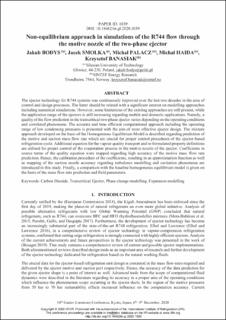| dc.contributor.author | Bodys, Jakub | |
| dc.contributor.author | Smolka, Jacek | |
| dc.contributor.author | Palacz, Michał | |
| dc.contributor.author | Haida, Michal | |
| dc.contributor.author | Banasiak, Krzysztof | |
| dc.date.accessioned | 2021-06-02T12:11:44Z | |
| dc.date.available | 2021-06-02T12:11:44Z | |
| dc.date.created | 2020-12-11T18:06:28Z | |
| dc.date.issued | 2020 | |
| dc.identifier.citation | Proceedings of the 14th IIR-Gustav Lorentzen Conference on Natural Refrigerants - GL2020 | en_US |
| dc.identifier.isbn | 978-2-36215-040-1 | |
| dc.identifier.issn | 0151-1637 | |
| dc.identifier.uri | https://hdl.handle.net/11250/2757409 | |
| dc.description.abstract | The ejector technology for R744 systems was continuously improved over the last two decades in the area of control and design processes. The latter should be related with a significant interest on modelling approaches including numerical simulations. However, some limitations of the existing approaches are still present, while the application range of the ejectors is still increasing regarding mobile and domestic applications. Namely, a quality of the flow prediction in the transcritical two-phase ejector varies depending on the operating conditions and correlated phenomena. The accurate and time efficient computational approach including the operating range of low condensing pressures is presented with the aim of more effective ejector design. The mixture approach developed on the basis of the Homogeneous Equilibrium Model is described regarding prediction of the motive and suction mass flow rate which are crucial for proper control procedures of the ejector-based refrigeration cycle. Additional equation for the vapour quality transport and re-formulated property definitions are utilised for proper control of the evaporation process in the motive nozzle of the ejector. Coefficients in source terms of the quality equation were mapped regarding high accuracy of the motive mass flow rate prediction. Hence, the calibration procedure of the coefficients, resulting in an approximation function as well as mapping of the suction nozzle accuracy regarding turbulence modelling and cavitation phenomena are introduced in this study. Finally, a comparison with the baseline homogeneous equilibrium model is given on the basis of the mass flow rate prediction and field parameters. Keywords: Carbon Dioxide, Transcritical Ejector, Phase change modelling, Expansion modelling | en_US |
| dc.language.iso | eng | en_US |
| dc.publisher | IIR | en_US |
| dc.relation.ispartof | Proceedings of the 14th IIR-Gustav Lorentzen Conference on Natural Refrigerants | |
| dc.relation.ispartofseries | Science et technique du froid; | |
| dc.subject | Carbon Dioxide | en_US |
| dc.subject | Transcritical Ejector | en_US |
| dc.subject | Phase change modelling | en_US |
| dc.subject | Expansion modelling | en_US |
| dc.title | Non-equilibrium approach in simulations of the R744 flow through the motive nozzle of the two-phase ejector | en_US |
| dc.type | Chapter | en_US |
| dc.description.version | acceptedVersion | en_US |
| dc.source.pagenumber | 6 | en_US |
| dc.source.issue | 14 | en_US |
| dc.identifier.doi | 10.18462/iir.gl.2020.1039 | |
| dc.identifier.cristin | 1858925 | |
| dc.source.articlenumber | 1039 | en_US |
| cristin.ispublished | true | |
| cristin.fulltext | postprint | |
| cristin.qualitycode | 1 | |
